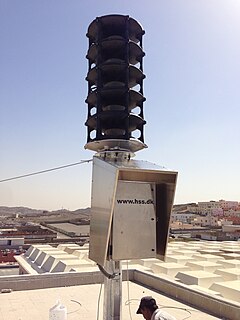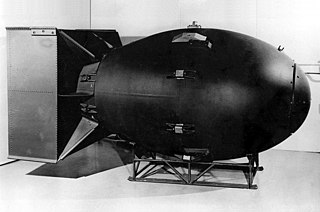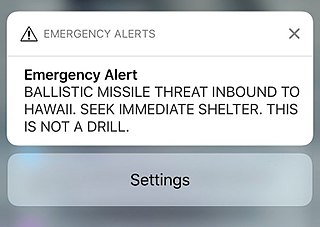
Civil defense in Finland is the responsibility of the Ministry of Interior under the Civil Defense Act of 1958. It is directed to provide civil defense to protect persons and property in wartime as well as in peacetime. The act stipulates that the ministry is responsible for providing shelters in high-risk areas, for evacuating civilian population from threatened areas, and for limiting damage from natural disasters. In emergency situations, firefighting, rescue, ambulance, and first-aid services are coordinated with the civil defense effort. Civil defense operations are entirely a civilian responsibility.

The Ministry of the Interior is one of the Finnish Government's twelve ministries, which is responsible for matters related to internal security such as counter-terrorism, policing, fire & rescue services, and border control, as well as migration issues. The ministry is led by the Minister of the Interior, Kai Mykkänen of the National Coalition Party

War is a state of armed conflict between states, governments, societies and informal paramilitary groups, such as mercenaries, insurgents and militias. It is generally characterized by extreme violence, aggression, destruction, and mortality, using regular or irregular military forces. Warfare refers to the common activities and characteristics of types of war, or of wars in general. Total war is warfare that is not restricted to purely legitimate military targets, and can result in massive civilian or other non-combatant suffering and casualties.

Peace is the concept of harmonious well-being and freedom from hostile aggression. In a social sense, peace is commonly used to mean a lack of conflict and freedom from fear of violence between individuals or heterogeneous groups.
The ministry delegates the implementation of national policy to county and municipal authorities, which act through locally appointed civil defense boards. These boards supervise operations from more than 100 civil defense centers designated throughout the country. Personnel in national and local government agencies, committed to civil defense in emergency situations, and in independent voluntary organizations that would come under their jurisdiction number over 100,000. Nongovernment organizations involved in civil defense activities include the Finnish Red Cross and the Rescue Service. Police are also assigned to reinforce civil defense workers as conditions require.
The municipalities represent the local level of administration in Finland and act as the fundamental, self-governing administrative units of the country. The entire country is incorporated into municipalities and legally, all municipalities are equal, although certain municipalities are called cities or towns. Municipalities have the right to levy a flat percentual income tax, which is between 16 and 22 percent, and they provide two thirds of public services. Municipalities control many community services, such as schools, health care and the water supply, and local streets. They do not maintain highways, set laws or keep police forces, which are responsibilities of the central government.

The Finnish Red Cross is an independent member of the International Federation of Red Cross and Red Crescent Societies, which is one of the biggest and best-known international organisations in the world and in the field of humanitarian aid. FRC has over 90,000 members and around 45,000 active volunteers in Finland. FRC consists of 12 regional chapters and 550 local branches throughout the country. The current General Secretary is Ms. Kristiina Kumpula. At the end of 2006, the FRC employed 1,168 people, of which 136 worked at the headquarters in Helsinki.

Law enforcement in Finland is the responsibility of several agencies. The Police of Finland, a national police agency, is responsible for most tasks. The two other main agencies are the Finnish Border Guard and the Finnish Customs. Examples of other agencies with limited policing powers are the Finnish Defence Forces, municipal parking inspectors and railway staff.
An alarm system is in place in urban centers to warn the civilian population of threatened attacks. During an emergency situation, instructions would be broadcast through normal media channels. The early warning civil defense system is tied into the nationwide military air surveillance system.

A civil defence siren is a siren used to provide emergency population warning of approaching danger and sometimes to indicate when the danger has passed. Some are also used to call the volunteer fire department to go fight a fire. Initially designed to warn city dwellers of air raids in World War II, they were adapted to warn of nuclear attack and of natural destructive weather patterns such as tornadoes. The generalised nature of the siren led to many of them being replaced with more specialised warnings, such as the Emergency Alert System.

The Ministry of Interior maintains hard shelters, capable of accommodating 3.6 million persons, in cities and in other densely populated areas where two-thirds of the country's population live. They are built to withstand the detonation of a 100 kiloton nuclear bomb at ground zero. There is no shelter program in rural areas nor are most detached dwellings and townhouses equipped with shelters. About 10 percent of the shelters are carved out of natural rock, but most are beneath office and residential buildings. Some are designed for multiple use as parking garages, schoolrooms, skating rinks, and swimming pools. By law, builders are obliged to include shelters in blocks measuring 3,000 cubic meters or more. In the late 1980s, in Helsinki, 536,000 spaces were provided, of which 118,000 were in large rock shelters and 14,000 were in subway stations. The shelter space was sufficient to accommodate over 100 percent of the nighttime population of the city, but only 67 percent of the daytime population.

Helsinki is the capital city and most populous municipality of Finland. Located on the shore of the Gulf of Finland, it is the seat of the region of Uusimaa in southern Finland, and has a population of 650,058. The city's urban area has a population of 1,268,296, making it by far the most populous urban area in Finland as well as the country's most important center for politics, education, finance, culture, and research. Helsinki is located 80 kilometres (50 mi) north of Tallinn, Estonia, 400 km (250 mi) east of Stockholm, Sweden, and 390 km (240 mi) west of Saint Petersburg, Russia. It has close historical ties with these three cities.
The most serious shortcoming of Finland's civil defense system is that 1.5 million Finns had no access to shelters. Another reason for concern is that many shelters are poorly equipped and maintained. All shelters are supposed to be outfitted with self-contained power and ventilation systems, sanitary facilities, and emergency supplies. Nevertheless, inspections during 1986 found that two-thirds of shelters in private buildings had some deficiencies.
Contingency plans include massive evacuation of civilians from likely target areas, threatened with attack by conventional forces in time of war. Medical services for civilian casualties would be provided at local facilities in coordination with the civil defense branch of the Ministry of Social Affairs and Health. In the 1980s civil defense authorities considered, however, that evacuation of the civilian population to escape fallout following a nuclear attack would be pointless, and no provision was made for such a contingency.
The public's perception of civil defense efforts was marked by considerable indifference during the 1980s. Although its system was far more complete than the systems in most countries of Western Europe, Finland's annual expenditure per capita on civil defense of US$12 was well below the rate of other Scandinavian countries, which averaged US$20 per capita. The nuclear accident at Chernobyl in the Soviet Union in 1986 underscored Finland's vulnerability and triggered renewed concern over shortcomings in the civil defense program. In response, the government announced plans in 1988 to introduce an automatic radiation surveillance network to supplement the existing manual one and to ensure that an outdoor alarm system was operational in all municipalities. Now this network has been completed and is in operation. [1]

Western Europe is the region comprising the western part of Europe. Though the term Western Europe is commonly used, there is no commonly agreed-upon definition of the countries that it encompasses.










